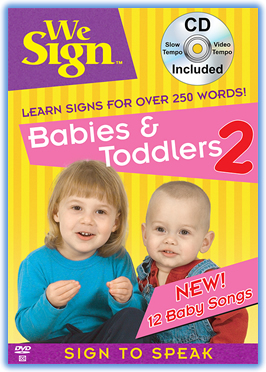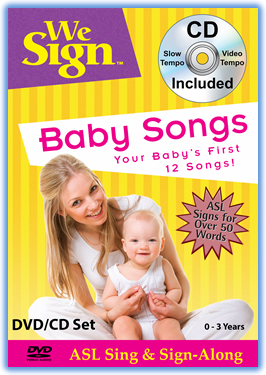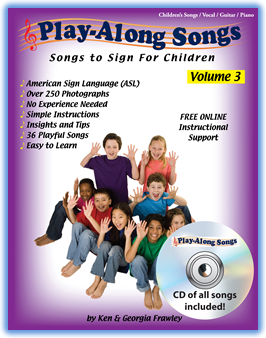
Baby Songs
Choosing, Teaching, and Using Activity Songs
with Babies (birth - 18 months of age).
Play-Along Songs books offer parents, teachers, early childhood professionals, and caregivers with a wide variety of songs that can be used with babies. Generally baby songs are simple and short like nursery rhymes, have just a few words, feature actions that can be performed with an adult holding the baby, and often include animal sounds for babies to learn.
It is important to keep in mind that during this beginning stage of life, development is occurring rapidly and there are vast differences between a newborn and a 16 month old baby. Everything including their ability to understand, comprehend, and their physical capabilities are very different.
When using children's songs with babies, you will need to address differences. , Our book Sign to Speak - Babies Can Talk and our DVD called We Sign- Baby Songs DVD/CD set provide you with instruction, activities and songs specifically designed to sign with babies. Many of the baby songs from both the book and DVD are found in Play-Along Songs Volume 3.
Nine important tips about baby songs.
- Choose short and simple songs. Nursery rhymes like Mary Had a Little Lamb have been used with babies for generations. They are simple, easy to sing and short. However, there are many songs and rhymes available, as well. Simply sing the chorus to the song or the chorus and a verse to a song. The more repetitive the words, actions, and sound, the easier it is for babies to learn and understand the words and concepts. Here is a demonstration of a song with simple actions and animal sounds that you can later adapt to be about any animal you choose. It is from Play-Along Songs Volume 3 and is called
Do You Hear the Ducky Sing?
- Choose simple movements and activities. Babies love to watch you enthusiastically sing and move. Here are some ideas for using songs with babies:
- Chose songs with movements that you can perform with your baby. Bounce them on your knee, clap their hands, move their legs like running, wiggle their bodies, move their arms like swimming, and so on.
- Movements become more independent and complicated as babies get older. Young babies' movements often begin with clapping, moving on to actions with their bodies and hands, and noises and sounds. . As babies get closer to the toddler stage, they want to perform more of the activities and complicated movements and make sounds on their own.
- American Sign Language, ASL, is a wonderful way to provide a visual and movement component to baby songs. ASL also provides babies with another way to learn language. ASL is a language that has proven to be a language that babies are capable of learning and using. that comes with many benefits All Play-Along Songs Volumes, especially Volume 3: Songs to Sign with Children, have songs with ASL. Watch this demonstration of ASL and a classic rhyme called
Mary Had a Little Lamb.
- Choose songs that are familiar and of interest to you and your baby. Singing can be made comfortable when you choose songs you are familiar with. Later add new songs for you and your baby to enjoy. They can be action songs, animal songs, early learning and communication songs, or fun signing songs with American Sign Language.
- Your singing voice or musical skills are not important. Babies just love to hear your voice, have you paying attention to them in a playful way, and to enjoy your touch.
- Learn to sing any new song first. All of our books offer free Online video
demonstrations, like the ones on this page for Mary Had a Little Lamb and Do You Hear the Ducky Sing? that provide clear demonstrations for you to use. - Have your baby’s attention when singing and playing musical activities.
- Follow your baby’s cues. If your baby’s interest changes, change the song or the words and activity.
- Keep baby song activities fun and playful. The more you enjoy the activity the more your baby will, also. Be enthusiastic and engaging. Don't force the activity on babies.
- Be creative. Once you learn and are using a baby song, become creative and change the words, actions, and sounds to be things of interest to you and your baby. A fun song for this is called Jumping and is found in Play-Along Songs Volume 1.. The action of jumping can be performed by bouncing a baby on your knee or lap. To make the song more playful for a baby, simply change the words to be more baby friendly actions like bouncing, wiggling, rocking, and clapping. As babies develop their motor skills, they will perform the actions themselves. Watch a demonstration of Jumping.



